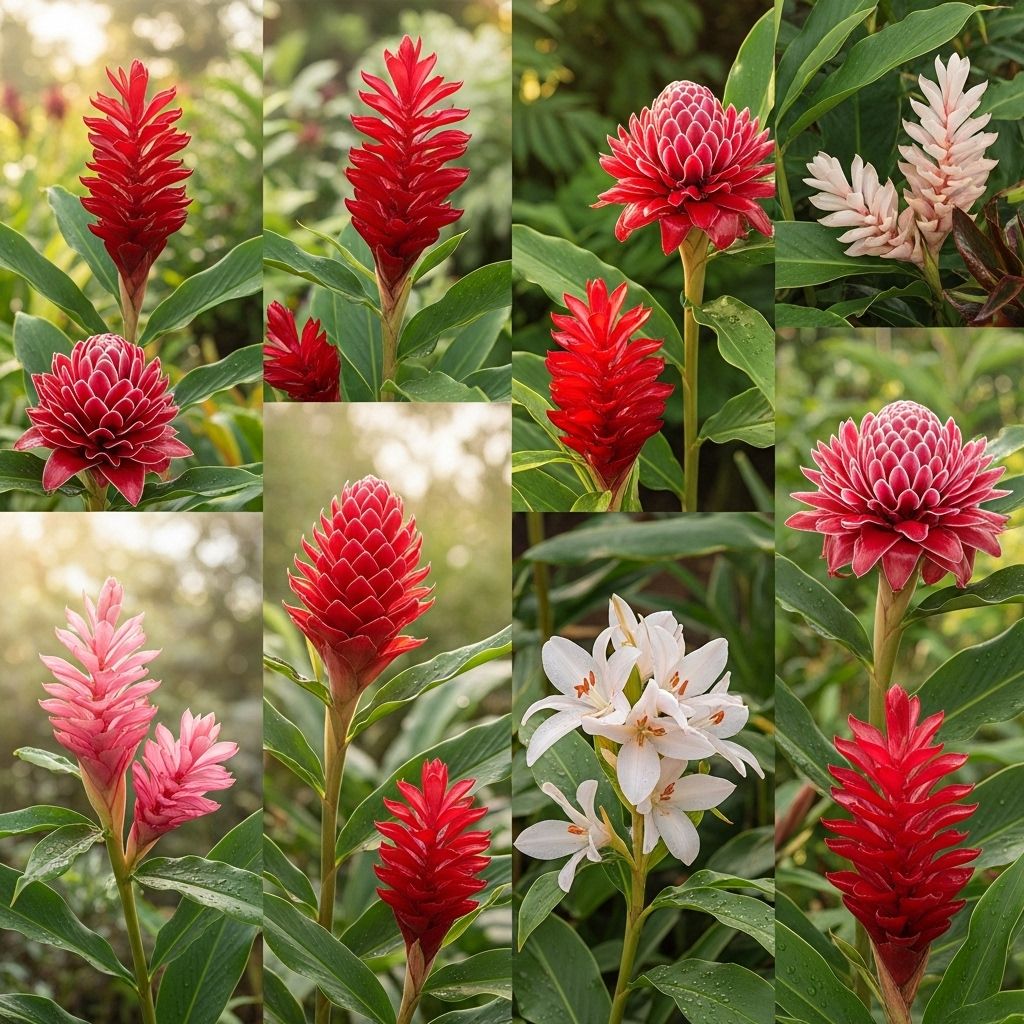Flowering Ginger Varieties: 13 Stunning Gingers To Grow At Home
Explore 13 breathtaking flowering ginger varieties for vibrant, fragrant, tropical gardens indoors or out.

Image: HearthJunction Design Team
13 Stunning Flowering Ginger Varieties to Grow at Home
Ginger is more than a zesty spice—it’s also a visually striking, fast-growing tropical plant that can transform any garden with vivid color and luxurious foliage. This article introduces 13 of the most beautiful flowering ginger varieties, each offering unique blooms, fragrances, and garden uses. Whether you’re looking to add drama to your landscape or fill your home with tropical flair, there’s a ginger variety to suit every space and gardener’s desire.
What Makes Flowering Ginger Special?
The ginger family (Zingiberaceae) is renowned for both culinary and ornamental members. While many gardeners know ginger for its edible rhizomes, the ornamental species are prized for their spectacular flowers, ranging from pristine whites and buttery yellows to vibrant reds and pinks. These plants are typically easy to care for, resilient, and attractive to pollinators, making them an excellent choice for garden beds, borders, containers, and even as cut flowers for arrangements.
Getting to Know Flowering Gingers
- Botanical Family: Zingiberaceae
- Native Regions: Tropical and subtropical areas of Asia, Pacific Islands, Africa, and the Americas
- Growth Habit: Clumping perennials, often with lush foliage and tall floral spikes
- Hardiness: Most varieties are suited for USDA zones 8-11 but some can be grown with winter protection in cooler zones
- Main Features: Dramatic floral displays, fragrant blooms, and lush, sometimes variegated, foliage
- Care Level: Generally low-maintenance, requiring well-draining soil and moderate moisture
Table of Contents
- Butterfly Ginger (Hedychium coronarium)
- Shell Ginger (Alpinia zerumbet)
- Red Ginger (Alpinia purpurata)
- Beehive Ginger (Zingiber spectabile)
- Spiral Ginger (Costus barbatus)
- Torch Ginger (Etlingera elatior)
- Pinecone Ginger (Zingiber zerumbet)
- Dancing Lady Ginger (Globba winitii)
- Hidden Ginger (Curcuma petiolata)
- Mango Ginger (Curcuma amada)
- Crepe Ginger (Cheilocostus speciosus)
- Peacock Ginger (Kaempferia pulchra)
- Yellow Ginger (Hedychium flavescens)
1. Butterfly Ginger (Hedychium coronarium)
Butterfly ginger boasts pure white flowers that resemble delicate butterflies. The blooms are fragrant, filling the garden with a sweet scent in late summer and early fall. This deciduous ginger dies back in winter and regrows in the spring, thriving in USDA zones 8-10 but often surviving in zone 7 with winter mulch. It’s a standout for pollinator gardens and makes exceptional cut flowers, with the fragrance lingering for days in a vase.
- Height: 3 to 6 feet
- Bloom Time: Late summer to early fall
- Best Uses: Borders, background plantings, and as a cut flower
2. Shell Ginger (Alpinia zerumbet)
Also called “Variegated Shell Ginger” for its striking gold-striped leaves, this species blooms with clusters of pink and white, shell-shaped flowers. It’s a showy, robust plant that can reach 8-10 feet tall in tropical climates. The foliage is often as prized as the flowers, lending bold texture and color to indoor and outdoor gardens alike.
- Height: Up to 10 feet
- Bloom Time: Late spring to summer
- Best Uses: Large containers, privacy screening, and exotic borders
3. Red Ginger (Alpinia purpurata)
Famed for tall, brilliant red flower bracts rising above dark green foliage, red ginger is an iconic tropical ornamental. Although it thrives outdoors in frost-free climates, it can also be grown indoors in large pots. The actual flowers are small and white, nestled within the vivid bracts.
- Height: 4 to 15 feet
- Bloom Time: Nearly year-round in ideal conditions
- Best Uses: Tropical landscaping, cut flowers, and floral arrangements
4. Beehive Ginger (Zingiber spectabile)
Beehive ginger gets its name from its unique, beehive-shaped flower bracts, which range from pale yellow to deep red. The true flowers emerge from these bracts. Popular for cut arrangements, the bracts can last for weeks, and the plant adds architectural interest to beds and borders. It requires warm, humid conditions to thrive.
- Height: 4 to 6 feet
- Bloom Time: Mid to late summer
- Best Uses: Tropical gardens, feature planting, and cutting gardens
5. Spiral Ginger (Costus barbatus)
Spiral ginger is admired for its distinctive spiraling stems and bright red cone-like bracts with yellow flowers. The plant provides both visual movement and color, making it a unique addition to any garden bed or border. It grows best in warm, humid environments and needs partial shade in hot climates.
- Height: 6 to 8 feet
- Bloom Time: Summer to fall
- Best Uses: Borders, accent plantings, and as a conversation piece
6. Torch Ginger (Etlingera elatior)
One of the most dramatic species, torch ginger produces towering flower spikes in pink, red, or white, with a waxy, torch-like appearance. These blooms are both edible and ornamental. Torch ginger is a culinary staple in Southeast Asia and a showstopper in tropical landscapes.
- Height: Up to 20 feet
- Bloom Time: Summer
- Best Uses: Large focal plant, edible flowers, and cut flower gardens
7. Pinecone Ginger (Zingiber zerumbet)
Also known as “Shampoo Ginger,” this species is harvested for its pinecone-like red bracts, which exude a fragrant, soothing liquid used as a natural shampoo. The bracts develop from green to red through the season and last well in arrangements. The foliage makes an excellent background for bolder flowers.
- Height: 3 to 6 feet
- Bloom Time: Late summer to fall
- Best Uses: Edible gardens, tropical beds, and as a novelty plant
8. Dancing Lady Ginger (Globba winitii)
This delicate ginger produces cascading sprays of purple and yellow flowers, which resemble dancing ladies. The gracefully arching stems and unusual coloration make it a favorite among collectors. Dancing lady ginger prefers partial shade and well-drained soil, thriving in warmer zones.
- Height: 2 to 3 feet
- Bloom Time: Summer
- Best Uses: Shade gardens, woodland borders, and containers
9. Hidden Ginger (Curcuma petiolata)
This variety is called “hidden” because its colorful bracts often appear close to the ground, partially concealed by the plant’s lush leaves. Hidden ginger offers vibrant pink, purple, or white blooms and dies back in winter in temperate climates, regrowing each spring.
- Height: 1 to 3 feet
- Bloom Time: Summer
- Best Uses: Borders, containers, and underplanting for taller species
10. Mango Ginger (Curcuma amada)
Mango ginger produces softly yellow bracts and is valued both as an ornamental and a culinary plant. The rhizomes of this ginger have a mild mango flavor, popular in Asian cuisine. Its lush foliage and cheerful flowers make it a versatile garden addition.
- Height: 3 to 4 feet
- Bloom Time: Summer
- Best Uses: Edible landscapes, containers, and borders
11. Crepe Ginger (Cheilocostus speciosus)
Crepe ginger stands out with white, crinkled (crepe-like) flowers emerging from dramatic red cones. The tall, upright stems and spiraled leaves bring height and movement to gardens. This species thrives in moist, rich soil and partial shade but adapts well to a variety of settings.
- Height: 6 to 10 feet
- Bloom Time: Summer to early fall
- Best Uses: Rain gardens, borders, and tropical beds
12. Peacock Ginger (Kaempferia pulchra)
Peacock ginger is a compact, groundcover-type ginger, beloved for its broad, strikingly patterned foliage, often marked with silver or purple. The small, violet flowers emerge just above the leaves, making this a wonderful underplanting or accent in shady areas.
- Height: 6 to 12 inches
- Bloom Time: Late spring to summer
- Best Uses: Groundcover, edging, and shade containers
13. Yellow Ginger (Hedychium flavescens)
Yellow ginger displays pale yellow, fragrant flowers that open in late summer and early fall. The scent is sweet and attracts a variety of pollinators. This variety grows in spreading clumps and is well-suited to borders and mass plantings for late-season color.
- Height: 4 to 6 feet
- Bloom Time: Late summer to early fall
- Best Uses: Pollinator gardens, mass plantings, and fragrance gardens
Flowering Ginger Care Tips
- Soil: Most varieties prefer rich, well-drained soil. Amend with compost for best growth.
- Light: Gingers grow best in partial shade, but some species tolerate full sun if well-watered.
- Water: Water regularly, keeping the soil consistently moist but not soggy. Reduce watering when dormant.
- Fertilizer: Feed with a balanced, slow-release fertilizer in spring and mid-summer for vigorous growth.
- Winter Care: In colder zones, cut stems back and mulch rhizomes heavily to protect against frost. Container-grown plants can be brought indoors.
| Ginger Variety | Flower Color | Height | Fragrance | Best Use |
|---|---|---|---|---|
| Butterfly Ginger | White | 3-6 ft | Yes | Borders, cut flowers |
| Shell Ginger | Pink/White | Up to 10 ft | Light | Screening, containers |
| Red Ginger | Red | 4-15 ft | No | Arrangements, landscaping |
| Beehive Ginger | Yellow/Red | 4-6 ft | No | Cut flowers, features |
| Spiral Ginger | Red/Yellow | 6-8 ft | No | Borders, accents |
| Torch Ginger | Pink/Red/White | Up to 20 ft | No | Focal, edible |
| Pinecone Ginger | Red | 3-6 ft | Light | Edible, novelty |
| Dancing Lady | Purple/Yellow | 2-3 ft | No | Shade, containers |
| Hidden Ginger | Pink/Purple/White | 1-3 ft | No | Borders, underplanting |
| Mango Ginger | Yellow | 3-4 ft | No | Edible, borders |
| Crepe Ginger | White/Red | 6-10 ft | No | Beds, rain gardens |
| Peacock Ginger | Purple | 6-12 in | No | Groundcover, edging |
| Yellow Ginger | Yellow | 4-6 ft | Yes | Borders, pollinator |
Frequently Asked Questions (FAQs)
Q: Do all gingers have edible roots?
A: No. While culinary ginger (Zingiber officinale) is edible, many ornamental varieties are grown solely for their striking flowers and foliage. Always research a species before consuming.
Q: How often do flowering gingers bloom?
A: Most varieties bloom annually, with individual flowers often lasting for a week or more. In tropical climates, some can flower almost year-round.
Q: Can flowering gingers be grown indoors?
A: Yes—most do well indoors in containers as long as they receive bright, indirect light and consistent moisture.
Q: Are ginger plants attractive to pollinators?
A: Absolutely. Many gingers offer abundant nectar and fragrant blooms, drawing bees, butterflies, and hummingbirds to the garden.
Q: What is the best way to overwinter ginger in cold climates?
A: In USDA zones below 8, either dig and store the rhizomes in a cool, dry place or heavily mulch outdoor plants after cutting back the stems.
Conclusion
Flowering ginger varieties offer a dazzling array of colors, fragrances, and forms. Whether you have a sunny backyard or a compact indoor space, these versatile plants can elevate your gardening experience. Choose your favorites, provide the right care, and you’ll enjoy an enduring display of tropical beauty—season after season.
References
Read full bio of medha deb












